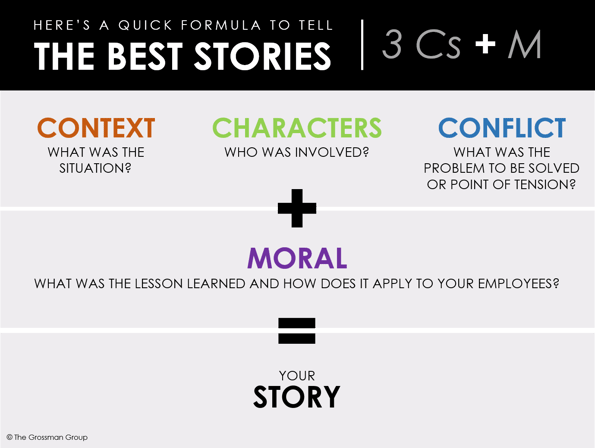
A good story brings ideas to life and inspires listeners to imagine themselves in the storyteller’s place as events unfold and lessons are learned. The vicarious experiences audiences feel when hearing stories can build an emotional connection – sensory details, actions and language that are part of a good story make the message memorable and impactful.
For leaders and communicators, storytelling is an important tool in our communications arsenal when we need to influence, teach and inspire people to take action. Renowned cognitive psychologist Jerome Bruner’s research finds that facts are 22 times more likely to be remembered if they are told in a story.
What makes a great story?
When creating a story, you want it to inspire and engage audiences, helping them gain new perspectives and create connections that assign meaning to circumstances or information. Whatever your end goal, an effective story should be:
- Simple, easy to tell and easy to remember – We want to engage quickly and break through the noise.
- Short and to the point – With so many information sources bombarding us at any given time, the average person’s attention span is only about eight seconds. This doesn’t mean your stories need to be told in under 10 seconds, but instead, is a good reminder to keep your stories succinct to hold your listeners’ attention.
- Purposeful and honest – Tie the story to the end result you want to achieve by positioning problems in the foreground and showing how they were overcome.
- Repeated – To broaden the audience and the reach of the message you want to keep telling your story and have others inspired to repeat it.
But how are stories we use in the workplace different from those we tell at a backyard BBQ? The main distinction is that the workplace story has a moral or a purpose. It has a punch line that helps an employee know what’s important and links the story to a desired behavior or outcome.
When composing a story to help reinforce a workplace goal, we suggest using a standard formula:
Context + Characters + Conflict + Moral = Your Story

See if you can find these key elements in this sample story:
“My wife and I are working on a home remodeling project that involves a house that we thought had great potential. After we bought it, we soon realized that it involved more work than we thought. In fact, we needed to tear it down to the studs and rebuild it. The whole experience reminds me of our work in the consumer-focused business. It’s like a house that needs remodeling, that was wonderful in its prime and now suffers from some deferred maintenance. But when we’re done, we know it will be profitable and, equally important, we’ll feel good about the work we did together. The key is that we’re all in this together.”
The context – having a home project that needs more work than you realized – is relatable to the audience on a personal level as well as a work one. The characters – the speaker and his/her wife – face the conflict of having to do more than they anticipated to get the job done. At the end of the day, the moral or lesson learned that applies to the employee audience is that the extra work will lead to positive results and ‘we’re all in this together.’
Storytelling for Leaders
Leaders use stories to advance various goals in their organizations, from helping employees connect to strategy and understand what success looks like with a real-life example, to explaining their future vision for a company transformation and building trust by sharing their personal challenges and experiences.
In fact, we recommend leaders develop a library of brief stories based on their own experiences that they can use to emphasize key messages, explain values or reinforce key behaviors.
One of our clients inspires her employees with stories about “the value of hard work” (a lesson learned in her formative years), “the importance of embracing differences” (a personal value developed while living in different countries) and “the power of focus and alignment” (an attribute of the company culture that she believes is instrumental to their success). Consider using this approach to develop your own library of great stories with morals, which can be integrated into your communications.
What Employees Want to Know About Their Leaders
As you develop stories that resonate and advance your goals, it’s helpful to consider and incorporate answers to the most common questions employees have for their leaders. I’ve outlined a few topics and questions below to help get you started.
Questions about you:
It’s not all about the organization, people want to know who you are, what’s important to you and how that might affect them, and have questions such as:
- How did you get to where you are?
- How do you want people to know you? What makes you tick?
- What are your expectations of employees?
- What should they expect of you?
- On what do you want to put a stake in the ground?
Leaders are the key source of information about the organization, its goals and how employees connect to the big picture. Creating stories that resonate can help drive employees’ understanding for questions like:
- What is your vision? What should various audiences believe in you and the vision?
- Who are we and what do we do?
- What are our business goals and strategies?
- What initiatives will drive the business today? In the future?
- What are the new behaviors you expect employees to perform successfully to achieve your results? How will we get the results needed?
- What does success look like?
- How will we measure success?
- What needs to change to make this happen?
Putting the Pieces Together
What you say is part of a larger internal communications effort that encompasses how and when employees receive the message, storytelling must be based on strategy and woven into a larger plan. When outlining an organization’s strategy or a leader’s vision in a message platform, for example, we develop messages and supporting points to advance the desired audience perception and the overall strategy. When this critical information is defined and confirmed, then the stories that make the messages personal and compelling are created and woven into the mix.
Storytelling can be a powerful way to support learning, inspire employees to action and help them connect with what’s important.
What morals are important for your employees to know through stories, and what are the key experiences you can share to build your story library?
—David Grossman
Whether they're complex, key messages or stories to share to create emotional connections with your employees, a leader platform is an essential tool we develop for leaders.

Comments on this post